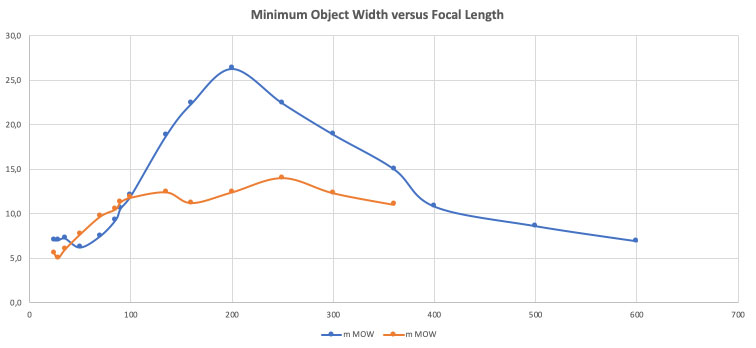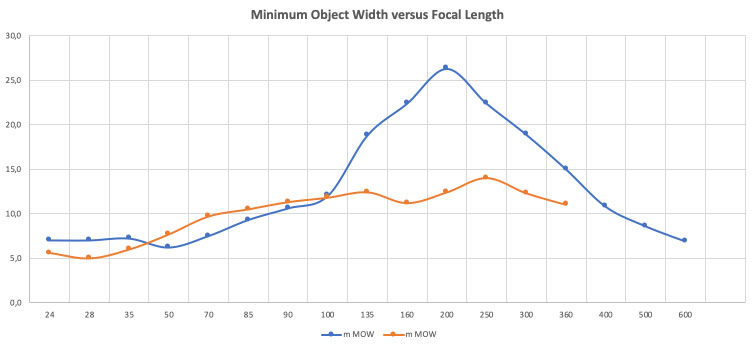Panasonic TZ202: Close-up Comparison with Sony RX10 M3
Introduction | Close-Up Capabilities | Including An Achromat in the Comparison... | Sample Photos (References) | References
On this page, I try to compare two cameras that are very different and, on the other hand, similar with respect to their close-up capabilities: the Sony RX10 M3 and the Panasonic TZ202. I bought both cameras with the intention to have more zoom range with an 1" sensor camera as well as a camera that I can use for shooting close-ups with a telephoto lens from a larger distance. Typical objects are butterflies that fly away if you get too close...
Introduction
The Sony RX10 M3 and the Panasonic TZ202 are two very different cameras that, by chance, share an 1" sensor (not the same one...). Comparing these cameras may not do justice either one. Nevertheless, I provide some comparison data here, because I bought both cameras for a similar purpose, namely for taking close-ups, particularly telephoto close-ups.
I bought the Sony RX10 M3 after I had used the Panasonic TZ202 for more than half a year and on three vacations, but felt that I was not content with the camera in some respects, particularly when taking photos of butterflies farther away. On the TZ202, the digital zoom would achieve a sufficient magnification (at 720 mm equiv.), but the results disappointed me (grainy). So I mused whether a camera with a 600 mm optical zoom, as the Sony RX10 M3 offers, might do the trick - and bought one fairly spontaneously... Actually, taking close-ups with a focal length of 600 mm may not be for everyone, for quite a number of reasons. Only experience will show, whether I will be happy with this...
On this page, I focus on the close-up capabilities. For the Sony RX10 M3, I also include shots with a +3 achromat, because this camera has a filter thread so that close-up lenses can, at least in principle be used. The Panasonic TZ202 does not have a filter threads, and I did not find a solution for this camera yet that is similar to the solutions that are offered for the Sony RX100 series.
Close-Up Capabilities
In the following, I compare the close-up capabilities of both cameras on the basis of the minimum object width at various focal lengths and also present photos from a "comparison shooting" at the "sweet spots" of the lenses for close-up shots. I do not discuss image quality here. That is a different topic...
Minimum Object Width
Neither Sony nor Panasonic disclose the maximum possible magnification for their cameras in macro mode. I took test shots to find out the minimum object width (which I find more useful than magnifications values) for both cameras and present my results in the table below:
|
Sony RX10 M3
|
Panasonic TZ202
|
|||||||
| Focal Length (equiv.) |
Distance from Sensor Plane* |
Minimum Object Width |
Max. Aperture |
Distance normal* |
Distance macro* |
Minimum Object Width macro |
Max. Apert. |
Focal Length (equiv.) |
| mm | cm | cm | f | cm | cm | cm | f | mm |
| 24 | 18 | 6.8-7.2 | 2.4 | 50 | 3 | 5.5-5.6 | 3.3 | 24 |
| 28 | 18 | 6.6-7.1 | 2.8 | 50 | 3 | 4.9-5.0 | 3.5 | 28 |
| 35 | 18 | 6.8-7.4 | 3.2 | 50 | 5 | 5.9-6.0 | 3.7 | 35 |
| 50 | 18 | 6.1-6.3 | 3.2 | 50 | 10 | 7.6-7.7 | 4.2 | 50 |
| 70 | 22 | 7.3-7.6 | 3.5 | 50 | 20 | 9.6-9.7 | 4.7 | 70 |
| 85 | 28 | 9.2-9.5 | 3.5 | |||||
| 90 | 31-32 | 10.6*** | 50 | 30 | 11.2-11.3 | 5.0 | 90 | |
| 100 | 36 | 11.4-12.7 | 4.0 | |||||
| 135 | 69 | 18.8-18.9 | 4.0 | 50 | 50 | 12.3-12.4 | 5.7 | 135 |
| 160 | 120 | 22.4*** | 50 | 50 | 11.0-11.4 | 5.8 | 160 | |
| 200 | 140 | 26.0-26.6 | 4.0 | 70 | 70 | 12.3-12.5 | 6.1 | 200 |
| 250 | 160 | 22.4*** | 100 | 100 | 14.0 | 6.3 | 250 | |
| 300 | 150 | 18.9 | 4.0 | 100 | 100 | 12.3 | 6.4 | 300 |
| 360 | 130 | 14.9-15.1** | 100 | 100 | 11.0 | 6.4 | 360 | |
| 400 | 110 | 10.7-10.8 | 4.0 | |||||
| 500 | 96 | 8.6 | 4.0 | |||||
| 600 | 92 | 6.8-6.9 | 4.0 | |||||
*) According to camera; for the Sony RX10 M3 note that the distance from the front of the lens body (not the lens) is much shorter (the distance between the focal plane and the front of the lens body differs depending on the focal length). **) Measured in February 2019. ***) Interpolated values
These are just coarse numbers, because I did not do "controlled" tests, and it was sometimes difficult to perform the tests. So there are variations in the numbers, but I think that the overall performance can be extracted from these numbers.
I consolidated these numbers a little bit to be able to create diagrams from them (table to the left). Both diagrams (to the right) show my mean minimum object width values across the focal length scale.
Do not take all this too seriously, but a few things can be easily read from these diagrams.
- Below a focal length of 50 mm (equiv.), the Panasonic TZ202 magnifies more, at nearly 50 mm, both cameras seem to perform about the same, and at 50 mm, the RX10 M3 is in the lead.
- Between 50 and 90 mm, the Sony RX10 M3 magnifies more, around 90 to 100 mm, both cameras seem to perform about the same again.
- From 100 mm up to the maximum focal length of the TZ202, which is 360 mm, the TZ202 is in the lead again.
- At about 400 mm, the Sony takes the lead, because the Panasonic does not offer focal lengths longer than 360 mm, and starts at about the same magnification, where the TZ202 leaves at 360 mm.
- Between 100 mm and 400 mm, the Sony RX10 M3 is not really "competitive" with respect to close-up photos (but it is not much worse than our two Sony RX100 models).
A few more remarks:
- The RX10 M3 lens has its "sweet spots" for close-up shots at 50 mm and 600 mm, the TZ202 lens at 28 mm, 160 mm, and 360 mm (with nearly the same magnification at 360 mm as at 160 mm).
- The minimum object width that the RX10 M3 can achieve is a little more than 6 cm at 50 mm; above 400 mm, the minimum object width decreases from nearly 11 cm to nearly 7 cm.
- The minimum object width filling a frame that the TZ202 can achieve are
about 5 cm at 28 mm; at 160 and 360 mm, the minimum object width decreases
to 11 cm, that is, to the same value that the RX10 M3 achieves at 400 mm
(and around 90 to 100 mm).
Note, however, that beyond 400 mm, minimum object width decreases to 7 cm at 600 mm for the RX10 M3. Thus, beyond the focal lengths that the TZ202 can offer, the RX10 M3 really shines.
The close-up behavior of the Sony RX10 M3 between the focal lengths of 100 to nearly 400 mm is odd to say the least. It seems to reflect the complexity of the lens. Usually, it is not a problem to magnify less, but for interior shots, the magnification at 400 mm may be too much at 1 m distance while you cannot step back to use a minimum distance between 1.2 and 1.5 m as is required for focal lengths between 200 mm and a little less than 400 mm. Perhaps focal lengths between less than 160 mm and 70-85 mm can help you out here and close the gap...
Minimum Object Width with Digital Zoom (Clear Image Zoom or Intelligent Zoom)
With Clear Image Zoom at the RX10 M3 and Intelligent Zoom at the TZ202, you can cut the minimum object width in half if you zoom electronically to 1200 mm or 720 mm respectively (equiv.). But what does this mean in practice? To answer this question, I will have to do a few more test shots...
Close-up Samples
The maximum width of the butterfly (Hamadryas belladonna) is about 6.8 cm. The following sample photos were taken mostly at the "sweet spots" for close-ups for both lenses.
Sony RX10 M3 |
Panasonic TZ202 |
|
 |
 |
|
50 mm (6.1-6.3 cm) |
24 mm* (5.5-5.6 cm) |
|
 |
 |
|
85 mm (9.2-9.5 cm) |
28 mm (4.9-5.0 cm) |
|
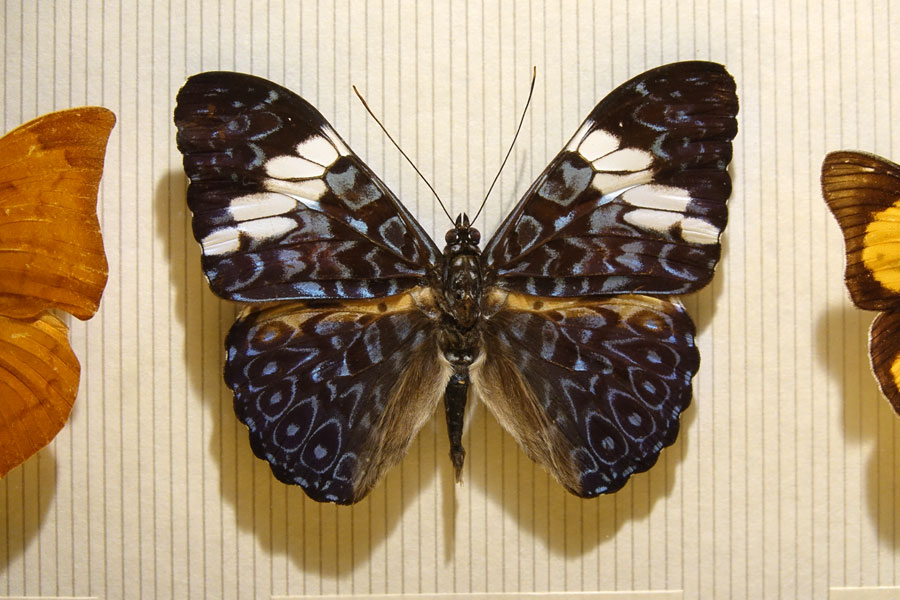 |
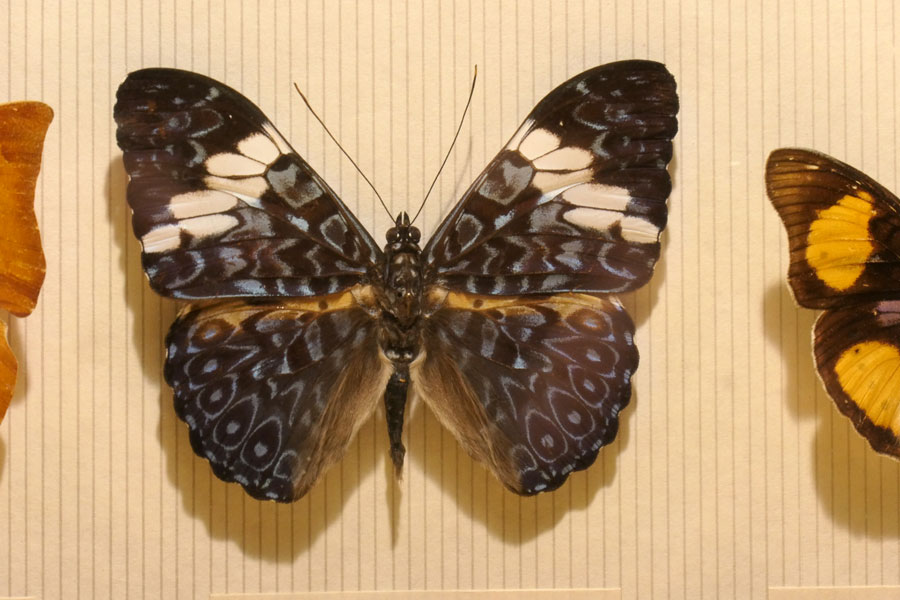 |
|
400 mm (10.7-10.8 cm; approx. 90 cm from lens) |
160 mm (11.0-11.4 cm; approx.50 cm) |
|
 |
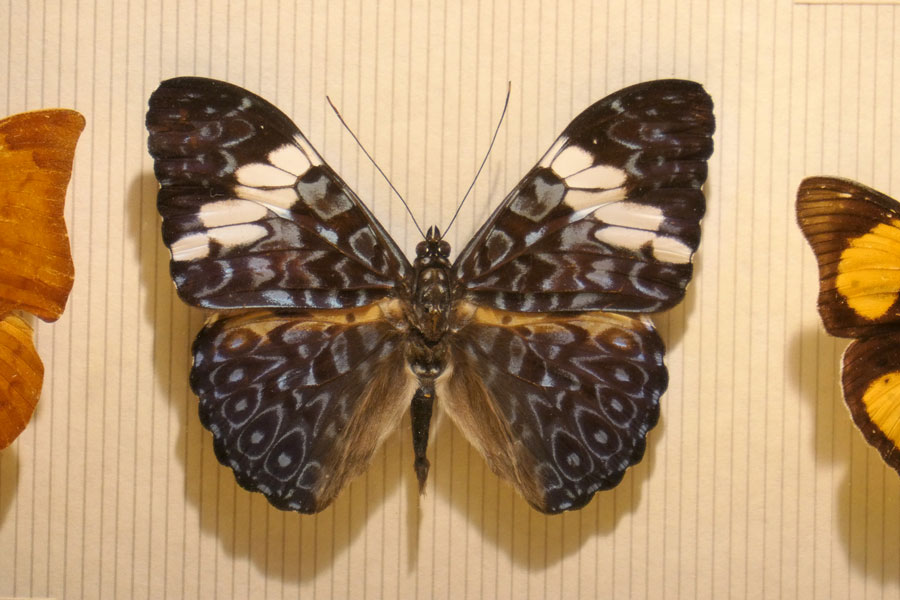 |
|
600 mm (6.8-6.9 cm; approx. 75 cm from lens) |
360 mm (11.0 cm; approx. 100 cm) |
|
 |
 |
|
1200 mm, Clear Image Zoom (digital zoom; 3.5 cm; approx. 72 cm from lens) |
720 mm, i.Zoom (digital zoom; 5.5 cm; approx. 100 cm) |
*) "Official" largest magnification, but I found out that 28 mm (equiv.) leads to a larger magnification than 24 mm (equiv.).
At the wide end, the TZ202 clearly outperforms the RX10 M3, which also also much more prone to casting a shadow on the object at 24 and 28 mm. Therefore, the sweet spot at 50 mm come to the rescue... At 160 mm and again at 360 mm, the TZ202 has about the same (relatively poor) performance as the RX100 M4 at 400 mm. Beyond that, the RX10 M3 magnifies higher, nearly cutting the minimum object width in half. At 600 mm, it has again about the same performance as at 24-35 mm. The digital zoom can cut the minimum object width at the longest focal length by half, but the quality is questionable. It might even be the better idea to scale up the photos in an image processing application to avoid increased camera shake caused by the extreme long focal lengths (the TZ202 also has performance issues at 720 mm).
In the end when just looking at the sample photos, one might be tempted to ask whether there is really an advantage for the RX10 M3 over the TZ202. I would say that there is definitely an advantage when shooting small objects from large distances. And I personally prefer the Sony processing of the images as well. This becomes more evident if you make sections of photos and scale these up.
Including An Achromat in the Comparison...
The Sony RX10 M3 offers a 72 mm filter thread at its lens, and I therefore bought a Marumi +3 achromat in order to find out in which ways it would improve the camera's close-up capabilities. In the following, I include this lens in the close-up comparison.
Minimum Object Width
The following table shows the numerical results with and without a +3 achromat with respect to the minimum object width at various focal lengths:
|
Focal Length |
Close-up Lens
Setup |
|||
| None | Marumi +3 Achromat |
|||
| (equiv.) | Minimum Object Width > |
MF closest | MF closest | MF infinity |
| 50 | 62 mm | n.a. | n.a. | |
| 85 | 92 mm | 67 mm | 149 mm | |
| 100 | 114 mm | 70 mm | 121 mm | |
| 135 | 189 mm | 70 mm | 89 mm | |
| 200 | 266 mm | 55 mm | 58 mm | |
| 300 | 189 mm | 38 mm | 40 mm | |
| 400 | 108 mm | 28 mm | 32 mm | |
| 500 | 86 mm | 24 mm | 26 mm | |
| 600 | 69 mm | 20 mm | 22 mm | |
For comparison the (more or less) same table for the Panasonic TZ202 without any close-up lens:
| Focal Length (mm) | 24 |
28 |
35 |
50 |
70 |
90 |
135 |
160 |
200 |
250 |
300 |
360 |
| Min. Distance normal (m)* | 0.5 |
0.5 |
0.5 |
0.5 |
0.5 |
0.5 |
0.5 |
0.5 |
0.7 |
1.0 |
1.0 |
1.0 |
| Min. Distance macro (m)* | 0.03 |
0.03 |
0.05 |
0.1 |
0.2 |
0.3 |
0.5 |
0.5 |
0.7 |
1.0 |
1.0 |
1.0 |
| Min. Object Size macro (mm) | 55-56 |
49-50 |
59-60 |
76-77 |
96-97 |
112-113 |
123-124 |
110-114 |
123-125 |
140 |
123 |
110 |
From a focal length of about 200 mm (equiv.) on, the Sony RX10 M3 reaches and surpasses the Panasonic TZ202, which has its best performance with respect to minimum object width in the wide angle range. At the telephoto end, the TZ202 can no longer compete with the RX10 M3/+3 achromat combo with respect to minimum object width. However, image quality also decreases considerably and noticeably beyond 200 mm on the RX10 M3, so that it is still an open question, whether it is worth it... This question can only be answered by further investigations under better lighting conditions.
Close-up Samples
It should be noted that the samples below do not allow to judge the image quality. Only tests at better lighting conditions would allow this.
Sony RX10 M3 |
Panasonic TZ202 |
|
 |
 |
|
600 mm, no close-up lens (7 cm m.o.w.) |
28 mm (4.9-5.0 cm m.o.w.), not the closest possible distance |
|
 |
 |
|
300 mm, +3 achromat (4 cm o.w.) |
28 mm (4.9-5.0 cm) |
|
 |
 |
|
600 mm, +3 achromat (2 cm m.o.w.) |
28 mm (4.9-5.0 cm m.o.w.) |
|
 |
 |
|
Ditto, sharpened (2 cm m.o.w..) |
repeated |
|
 |
 |
|
400 mm, +3 achromat (3 cm m.o.w.) |
28 mm (4.9-5.0 cm m.o.w.) |
|
 |
 |
|
500 mm, +3 achromat (2.5 cm m.o.w.) |
28 mm (4.9-5.0 cm m.o.w.) |
|
 |
 |
|
600 mm, +3 achromat (2 cm m.o.w.) |
Repeated |
m.o.w. = minimum object width
Sample Photos (References)
Sample close-up photos made with the two cameras can be found on the pages listed below.
Sony RX10 M3
Panasonic TZ202
References
Sony RX10 M3
See page Sony RM10 M3 Links
Panasonic TZ202
See page Panasonic TZ202 Links
| 08.02.2019 |
